This is a review of the Ernst Leitz (Leica) Elmar 9cm f/4 Collapsible lens. Hamish recently reviewed the huge and very fast TT Artisan 90mm 1.25. This is perhaps the antithesis of that lens.
Leica is a polarising company and there’s a lot of polarising opinions circulating about their products. One of them is if you want to make full use of Leica camera bodies, you absolutely must use Leica lenses. It’s because they are “the world’s finest”. So good in fact that the folks at Leica have come up with trademarked names for them (Elmar, Summicron, Summilux, etc) in order to establish them as “the finest in their class”. At least that’s what Chuck Norris of lens reviews (you know who I’m talking about) says, before immediately contradicting himself saying that actually those names on their own are meaningless, like Kleenex or Tang. And then calling Oskar Barnack “The Prophet”, ironically or not I honestly have no idea. Ever the wordsmith and always so measured…
Another well-known reviewer has come up with a “Magic Scale”, awarding each class of Leica lenses with 1-5 Ms. The Elmars received a modest rating of MMM and a half. Seemingly respectable but also the lowest of the bunch. Interestingly (or not interestingly at all), the Magic rating seems to correlate with the maximum aperture. See, the Elmar designation is reserved for lenses with the very moderate maximum f-stop of 3.5 and 4 (very occasionally 2.8 as well). Then comes Elmarit (f/2.8), Summarit (f/2.5), Summicron (f/2), Summilux (f/1.4), and finally Noctilux (f/1.2 and faster).
This also means that the Elmars are among some of the most affordable and attainable Leica lenses. Contrary to another popular belief, you don’t need to spend thousands in order to acquire genuine Leica glass. All hype aside, I’d venture a guess that there probably were no bad lenses in the Leica line-up over the decades so the decision whether you should get yourself a Leica lens is more a financial one than a question of quality. There’s plenty of vintage lens magic in even their cheapest options.
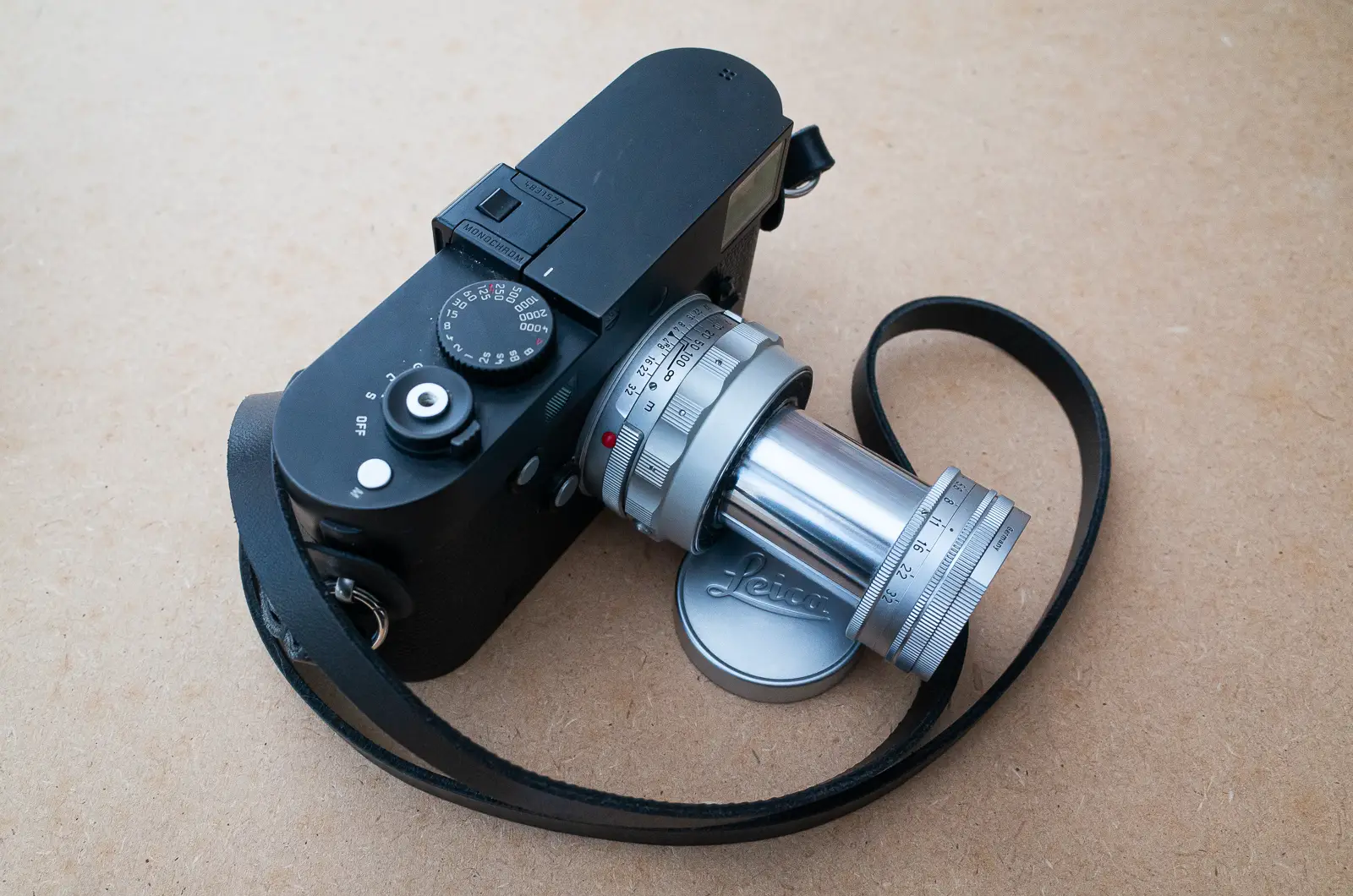
Background
So far in my reviews I’ve been focusing on Nikon lenses for LTM. I’ve never been averse to desecrating a Leica camera body with third party lenses and besides Nikkors I’ve also owned and used several Voigtlanders and Canons, as well as an occasional Zeiss, Rokkor, or MS Optics. If you are unsure about the idea of mounting third party lenses on a Leica, then have a read of this.
When compiling notes for this review I noticed just how badly Nikon spoiled me with the abundance of vintage lens information available online. In their official The Thousand and One Nights series they give you insight into not only who designed any of the dozens of lenses covered but also go into ridiculous detail on the process, often going way over the average reader’s head (mine for sure) with technical details regarding lens formulas. Leica on the other hand offers surprisingly little official information on their vintage lenses, at least online. When researching a lens you need to rely on wikis, third-party reviews often written by authors specialised in Leica serving as unofficial brand ambassadors and perpetuating the magic myth, and forums where users tend to talk in code and at times offer contradicting or incomplete information.
The full inscription on the front of the lens reads Ernst Leitz Gmbh Wetzlar Elmar f=9cm 1:4. The name Elmar comes from one of the earliest of Leica’s lenses – the Elmax, which stood for Ernst Leitz and Max Berek. If Oskar Barnack is the father of Leica camera bodies, Polish-born Max Berek is the father of their lenses, having designed the first 20. Back then the lenses weren’t being named to indicate their class or superiority, but rather after stuff like the designers’ pets.
The Berek-designed Summarex 85mm f/1.5 lens was named after his dog Rex who’d come to the factory every day to fetch his master for lunch. The Hektor line of lenses were named after his other dog, Hektor. Like almost all early M-mount 90mm lenses, this one was created by the most prolific of Leica lens designers, dr. Walter Mandler, who had been in charge of designing nearly 60 of their lenses over the course of his career. It started off as a simple triplet design and evolved from there. The lens version reviewed here is for the M mount and has been in production from 1954 to 1968 (my particular copy is from 1957).
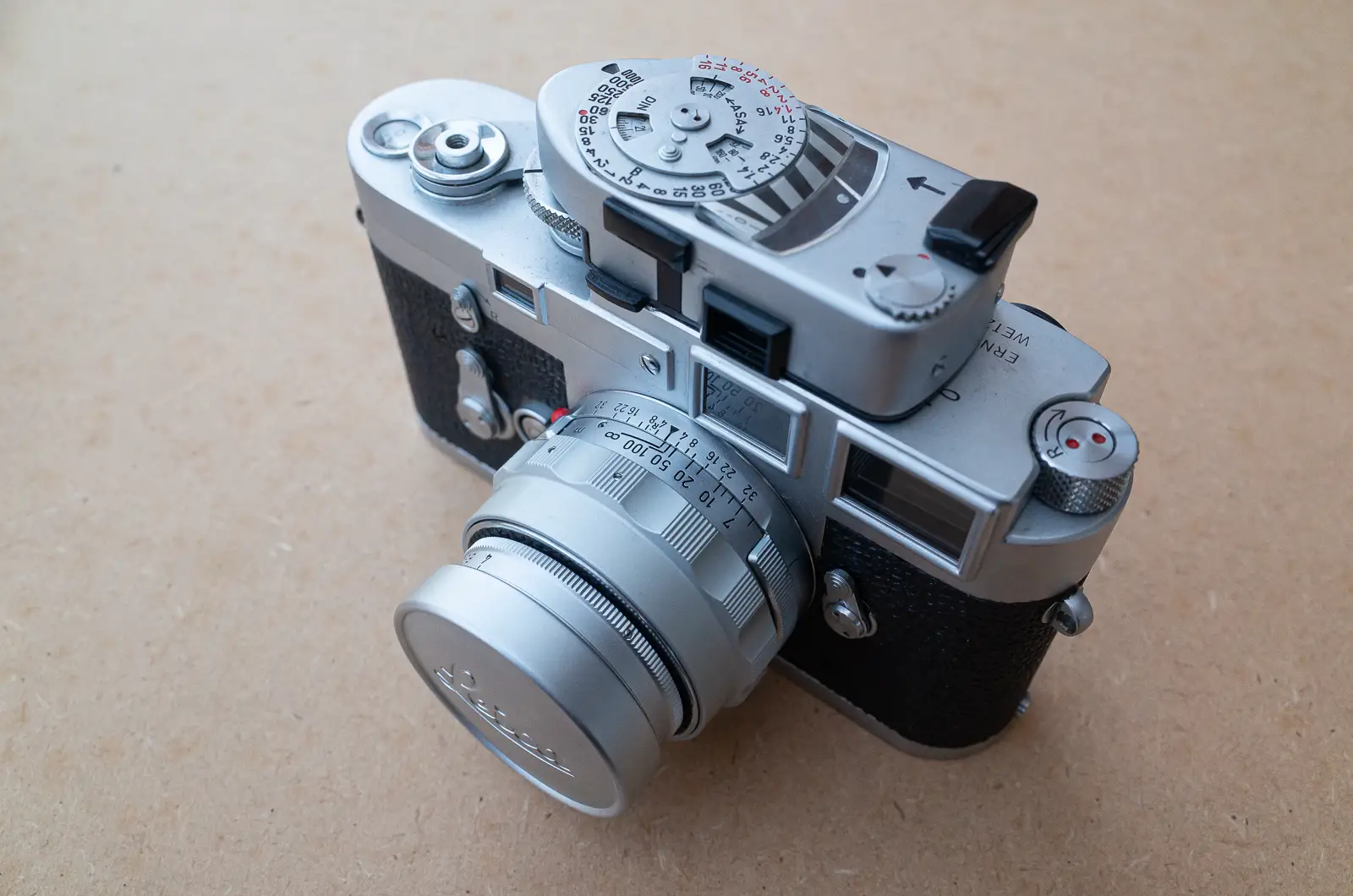
The 9cm Elmar evolved from a simpler 3 element design into 4 elements in 3 groups as seen in this version and later into 4 elements in 4 groups. You can easily tell a lens is an early example, even as far as screw mount lenses go, by the filter size (they used the A36 clamp-on filters as opposed to later 39mm screw-in ones) and a different aperture scale (instead of the more familiar scale of 4, 5.6, 8, etc the earlier lenses use 4, 4.5, 6.3, 9, etc). Besides the Macro-Elmar, this is the only collapsible 90mm Elmar. The earlier variants and the later Elmar-C are all rigid. 90mm lenses generally require a simple design and all offer very good image quality. If you can get a rigid 4/3 lens in LTM or M-mount it’s probably going to be the best bang for your buck. The collapsible version is more expensive and less practical.
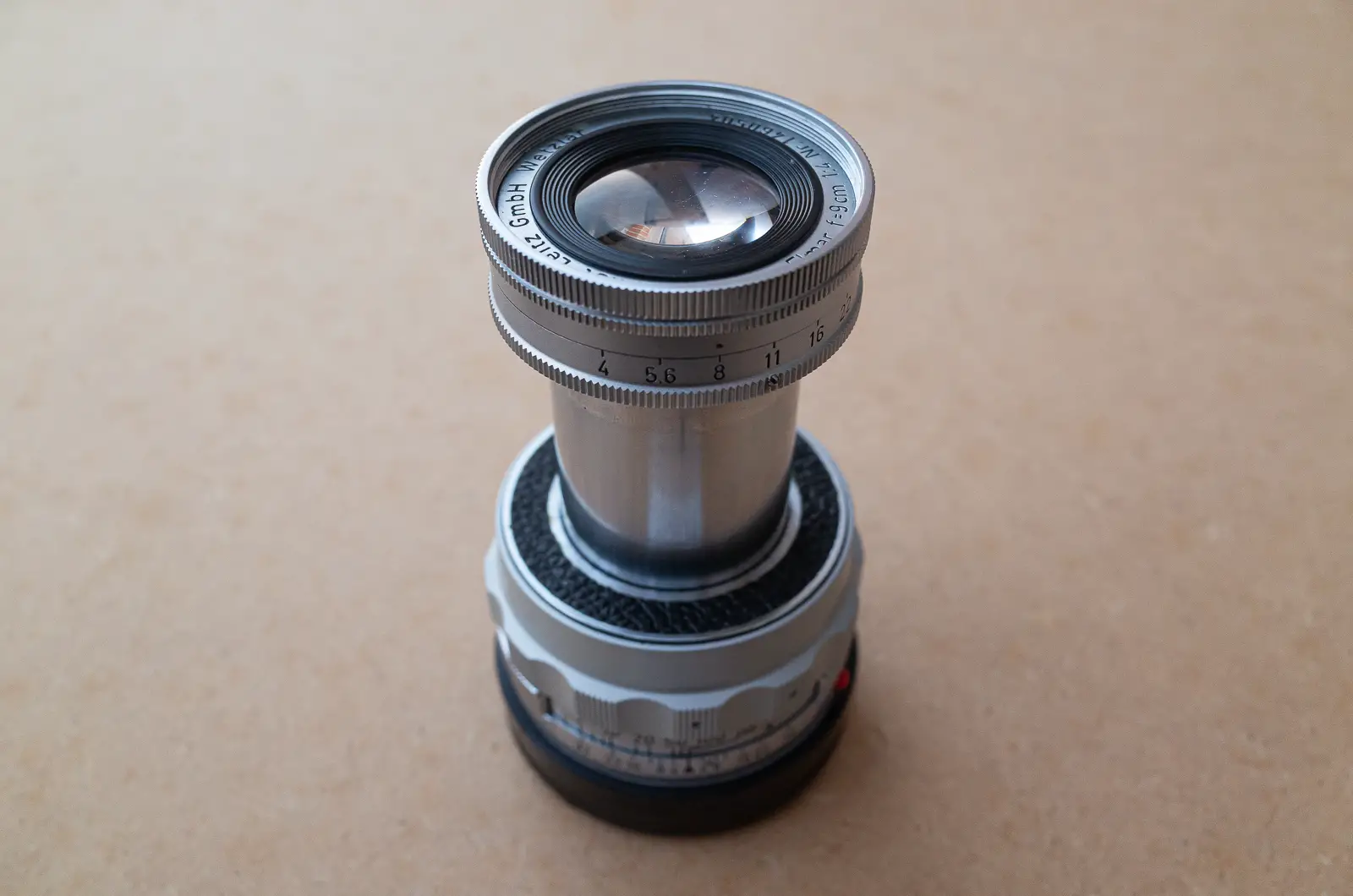
In order to easily distinguish among the various versions of their camera bodies and lenses, Leica used product codes that you might find useful especially if you’re looking for something very specific. At first they used strings of 5 letters and later strings of 5 numbers. The codes for this version of the lens are ILNOO / 11631. The codes aren’t exclusive to cameras/lenses and are useful when researching all sorts of accessories like hoods, caps, filters, finders, etc.
Build and handling
First things first. Just like with most collapsible lenses, it’s best to resist the urge to try and collapse the 9cm Elmar on a digital camera body. This is where I found contradicting reports – some say you can collapse it to a point (as long as you mount it fully extended), but not too far because then it can hit the shutter. In order to avoid this, you can use a rubber ring on the lens barrel that will physically prevent it from collapsing all the way. Others say that the advice above works for other collapsible lenses but not this one as it has a much wider rear element than, for example, the 50mm f/3.5 Elmar and it might hit the focusing cam.
The conflicting reports might have something to do with the fact that some digital Leica camera models handle collapsible lenses better than others. I simply expand and lock the lens before mounting it on my digital body and never collapse it. On film bodies it’s generally ok to collapse, except on the Leica M5 and CL as they have a swing metering arm that can hit the back of the lens if you’re not careful.
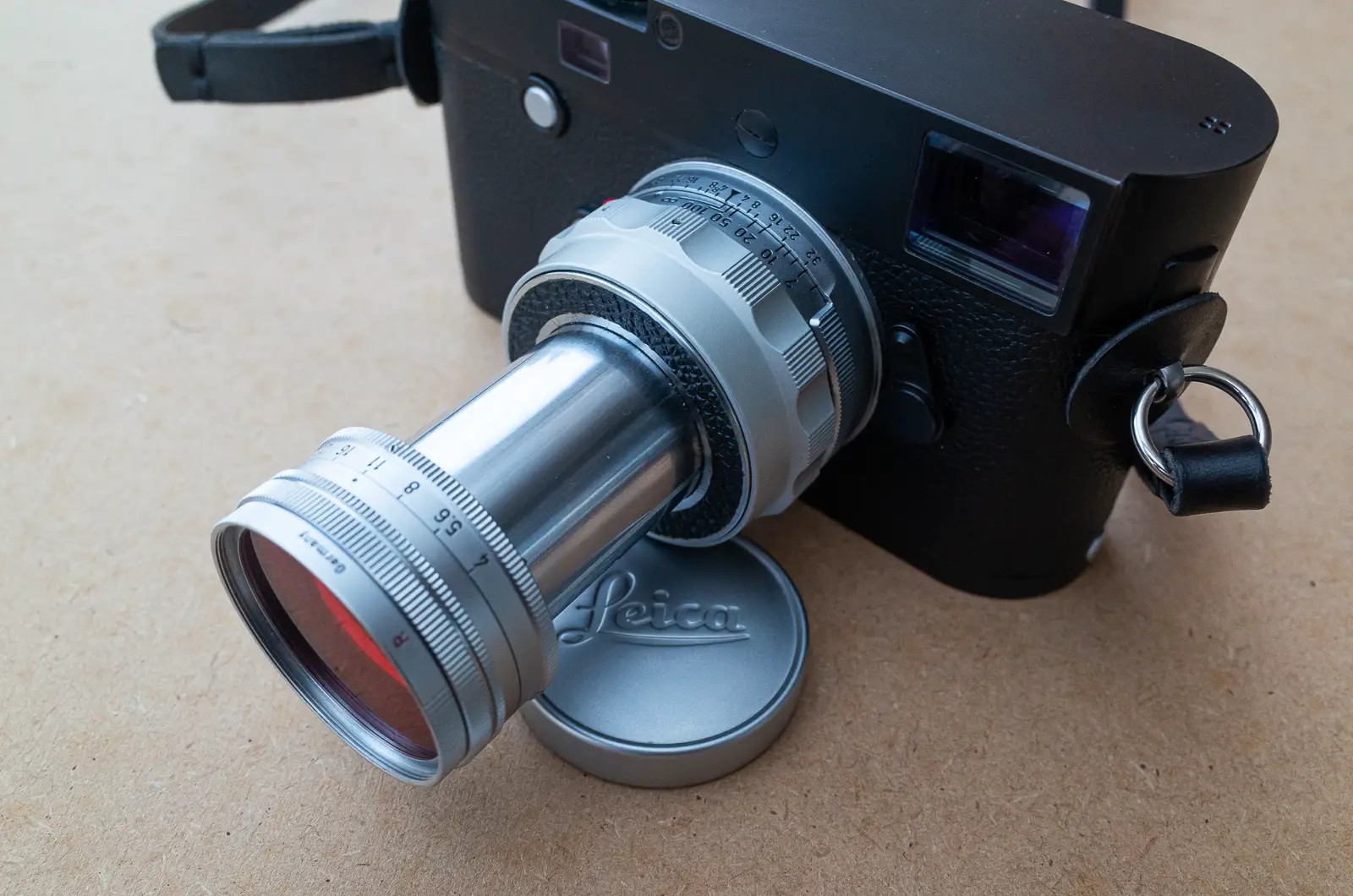
Speaking of collapsing the lens, you can only focus the 9cm Elmar if the lens is extended and locked into position (quarter turn counter clockwise if the mount faces in your direction). It has a release button that additionally locks the focus at infinity but it won’t unlock the focusing ring if the lens isn’t fully extended and locked. Similarly, you can only collapse the lens if you first focus it back at infinity. This feels very sturdy and I don’t think it will break easily if you struggle with it a bit, but obviously try to be gentle, this is a 60+ year old lens.
Locking/unlocking the lens on my copy works very smoothly and offers just the right amount of resistance. This is where this lens shines in terms of build quality, each movement and lock fills you with assurance that the mechanism works correctly. Those who love the tactile feel of vintage lenses will appreciate this. Additionally the lens features a leather(ette?) bumper for when you collapse it all the way that prevents metal parts from crashing into each other. Thanks to this, collapsing the lens is very quiet.
The focusing ring is at the base of the lens. It’s a large scalloped ring that’s very comfortable to use. The focusing scale is in metres. The minimum focus marking is 1m but the lens focuses a bit closer than that. The lens extends by about 1cm when focused at minimum distance. There is a depth of field scale as well as an infra-red indicator dot.
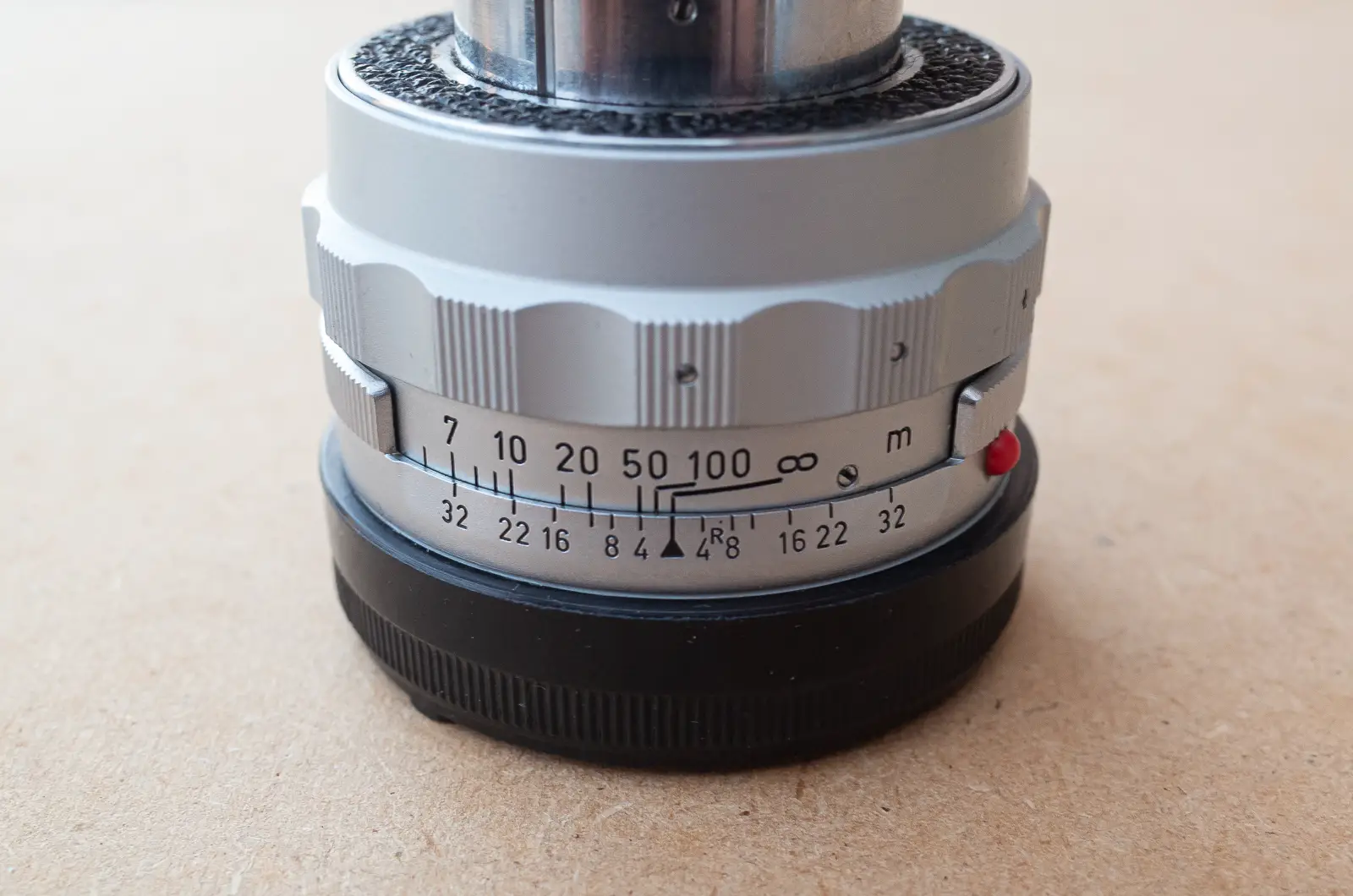
I really like the infinity lock on this lens, the only issue is it’s small and you need to learn to remember where it is otherwise you’ll have to take your eye away from the viewfinder. What I like about the 9cm Elmar, unlike practically all my other lenses with infinity locks, is that it doesn’t make it difficult to focus right before infinity. On other lenses there’s a small range of focus that’s difficult to use between where the lock starts engaging and where it’s locked at infinity. Not here, the lock engages only when it actually reaches the infinity setting.
On a Leica rangefinder, one important factor is the viewfinder coverage. Due to the small mouth of the lens, it stays well outside the 90mm framelines at infinity and without the hood attached. The lens encroaches ever so slightly into the corner when focused at minimum distance. When using the hood, the coverage is more extensive which might be a bit annoying when trying to compose. Personally, I usually don’t use the hood and just go with the picture it produces, flare and all.
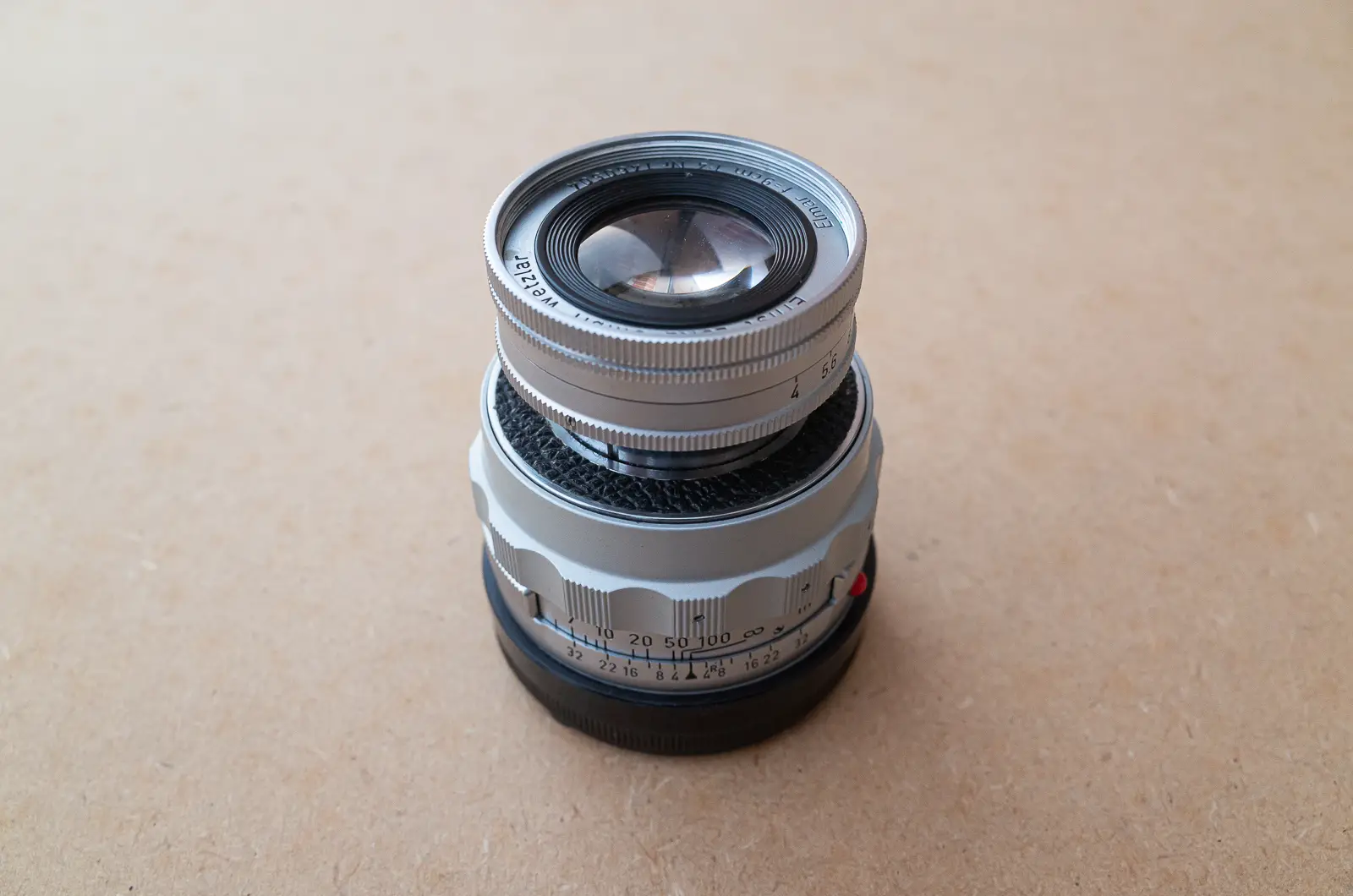
The aperture ring on the 9cm Elmar is at the end of the lens. It features a familiar modern aperture scale of 4, 5.6, 8, 11, 16, 22, and finally 32. The ring clicks at 1 stop intervals. My only issue with it is it’s almost impossible not to turn it when you’re trying to lock the lens in its extended position. Other than that it’s comfortable, not too slim, and easy to grip. The aperture itself features 10 mostly straight blades.
The collapsible 9cm Elmar is an eye-catching lens. You will not blend in when shooting with it and be prepared to be asked questions. In a good way. Even among other vintage chrome lenses it clearly stands out and looks very unusual. The finish is satin chrome for the most part, gloss on the collapsible barrel and the barrel that extends as you focus closer. The lens feels heavy and solid, like you would expect a brass lens to feel. There’s no slack, play, or wobble on any of its components. It’s back-heavy and feels well balanced. Overall it’s a testament to how much attention to detail the Leica designers put into their creations. Compared to some other Leica offerings, this lens is very affordable but nothing about it feels even remotely cheap.
Dedicated and compatible accessories for the 9cm Elmar
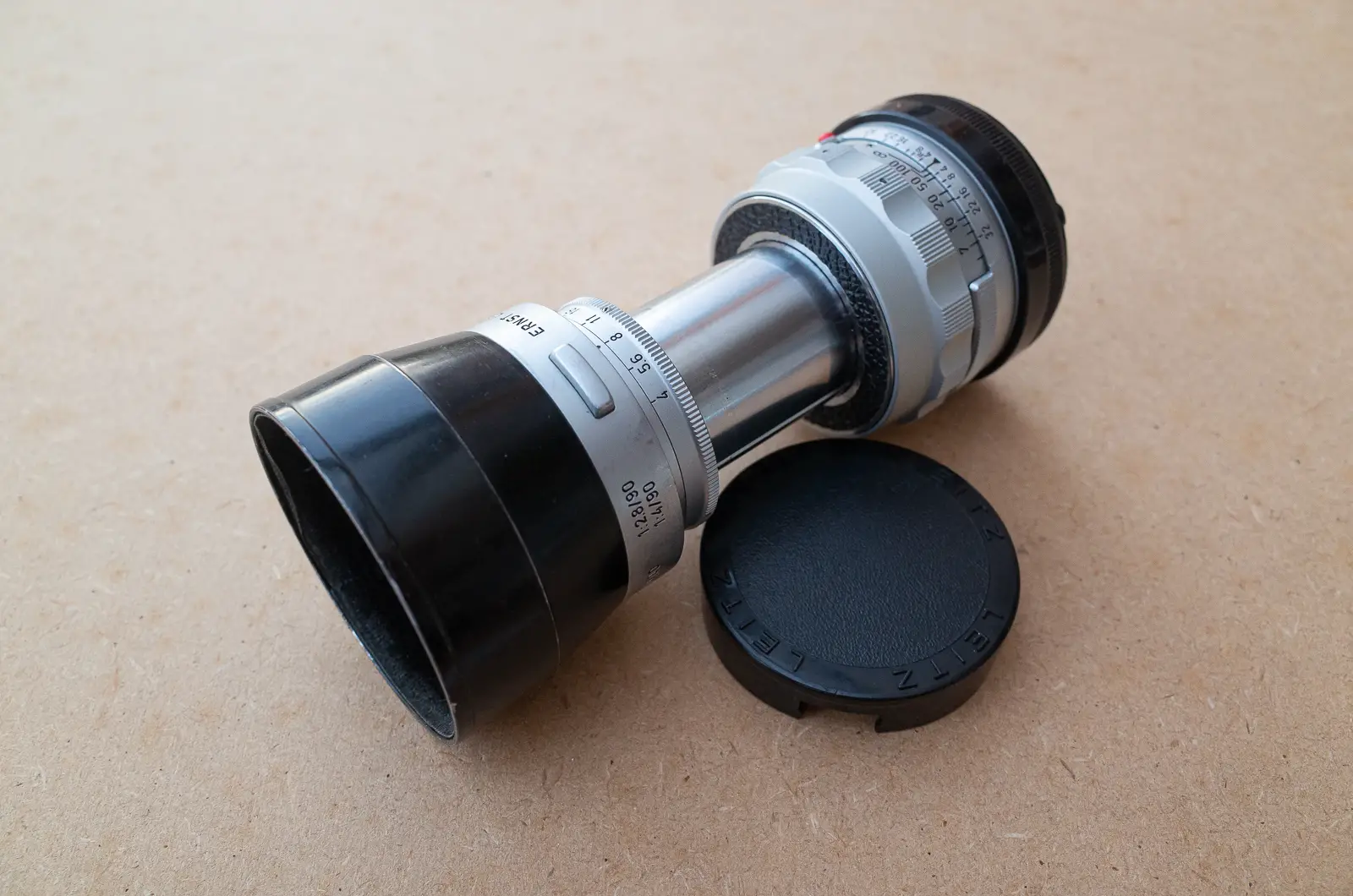
The product code for the dedicated hood for this lens is IUFOO (also compatible with 90mm f/2.8 and 135mm f/4.5) and the plastic push-on cap that slides over the reverse-mounted hood is 14033. Personally I love how these elements fit together. It’s a bit like a transformer. The metal hood clips onto the groove running around the outside of the 9cm Elmar barrel in regular and reverse position and fits snugly over the lens. On the inside it features a strip of velvet fabric that protects the lens from getting scratched. Wearing the hood over the lens decreases the overall size to better fit in your bag or coat pocket and protects the lens against bumps or dust. The lens, when extended and with the hood and rear cap on, is 13cmm long. The size when collapsed and with the reverse-mounted hood and both caps on is 7cm long and 5.5cm wide. The whole package feels solid, like a hand grenade I imagine.
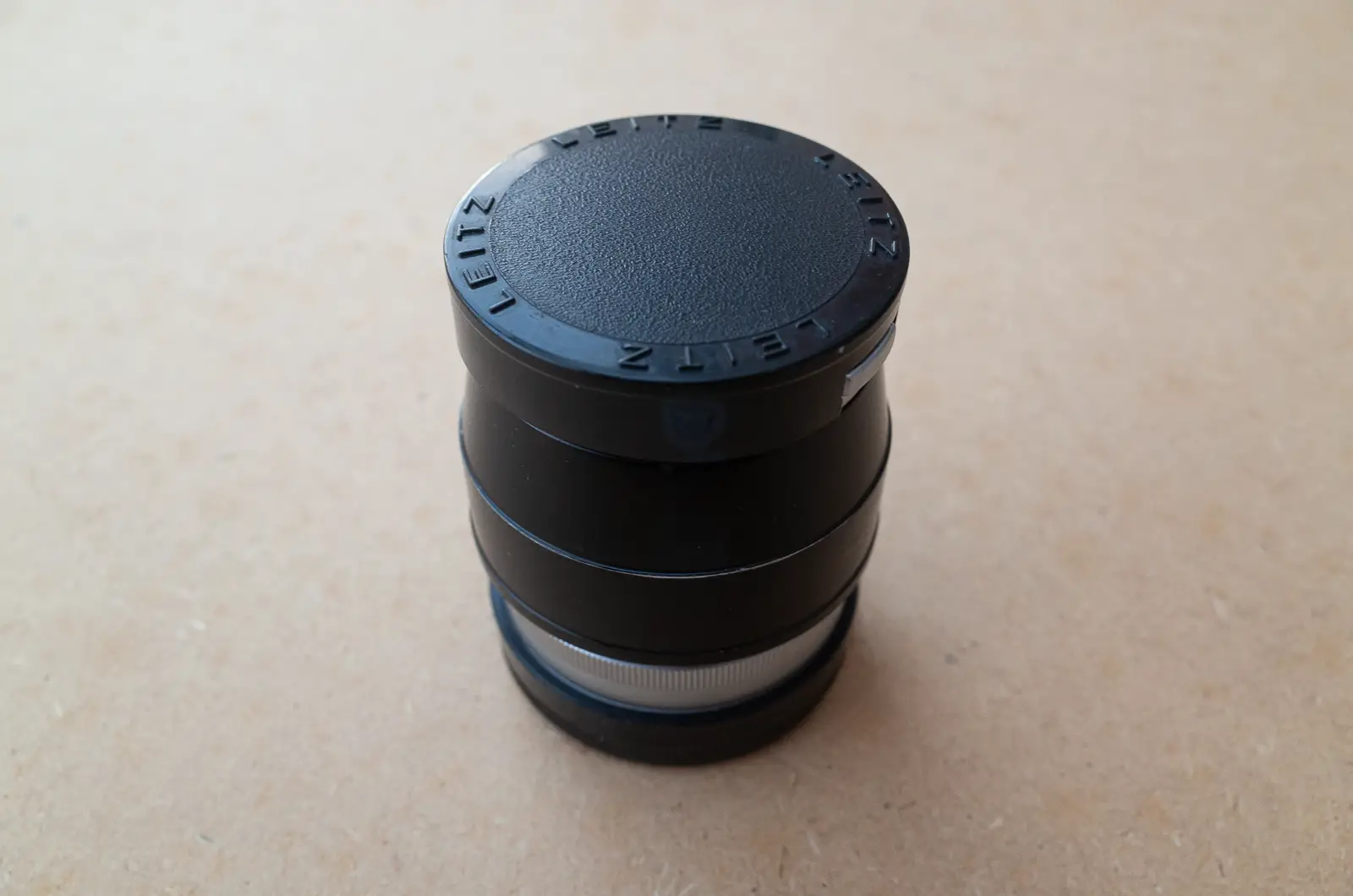
If you don’t like using a hood, you can also use an A39 slip-on cap to protect the lens. Together with a deep rear cap from a Super-Angulon, that will allow the lens to collapse all the way, it also provides sufficient protection for storage and transport. I wouldn’t use the deeper rear cap if used with the reversed hood though as the lens will sit deeper within the hood and it might start rubbing against the part of the hood’s inside no longer lined with the strip of velvet fabric.
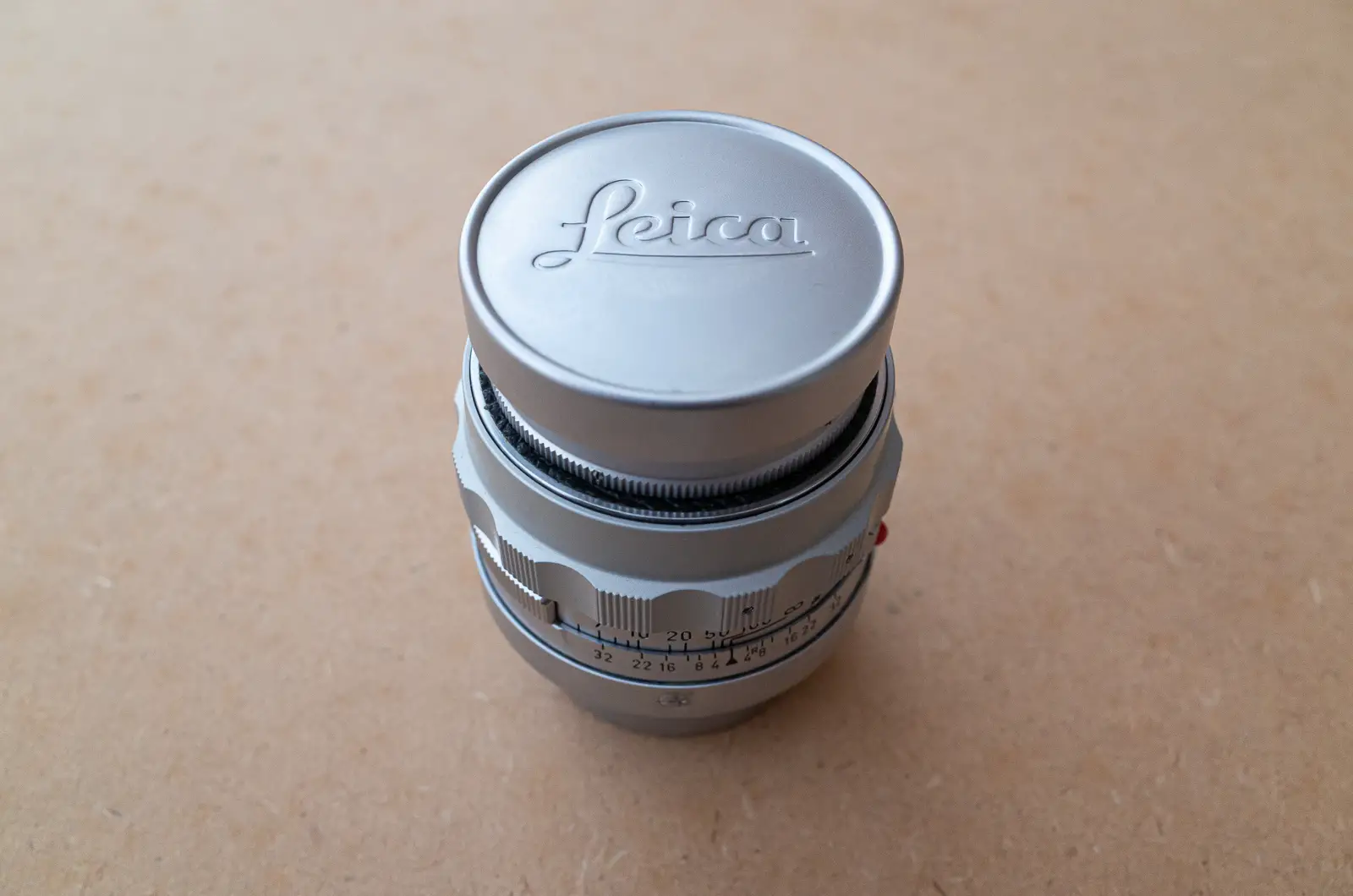
The lens takes 39mm screw-in filters. To this day it’s a very popular size and it’s easy to find these filters, both vintage and modern. The rim around the filter thread is quite thick, more than 1mm, which probably means it won’t ding easily if you bump the lens into something. It’s one of the most common types of mechanical lens damage I see and most of my vintage lenses have that rim half as thick.
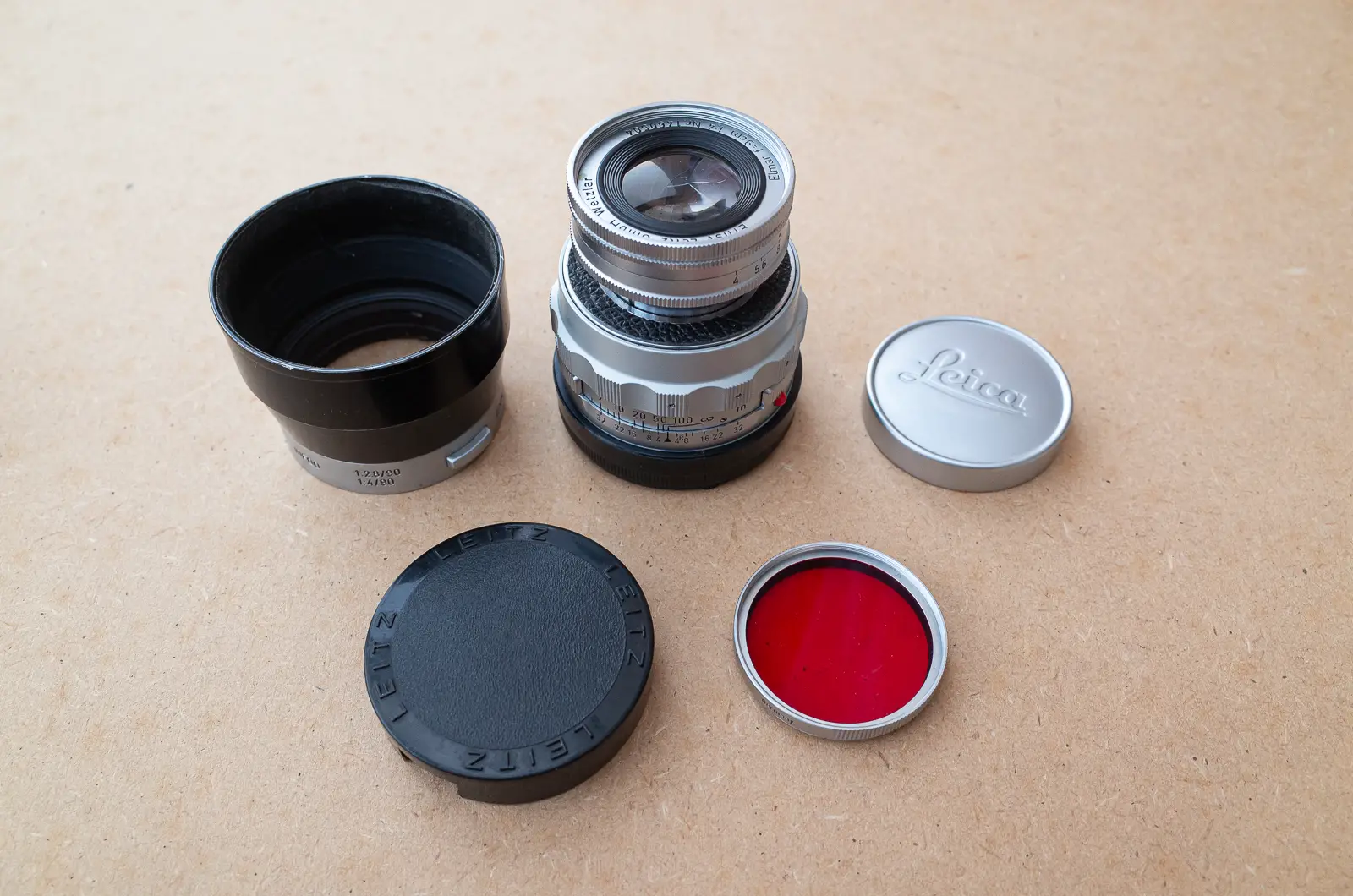
9cm Elmar image quality
As usual, the following are not test shots but simply the sort of photography I do. All have been taken on the Leica Monochrom typ 246 so unfortunately I can’t comment on such aspects as chromatic aberration. Worth noting this camera allows almost any lens to shine due to the sensor construction and the lack of the colour filter array, however it’s also not a very recent camera and newer digital colour bodies surely compensate for this with the resolution much higher than the modest 24 megapixels.
The first time I took it out for a spin, the sky was overcast so instead of my favourite red filter I used a yellow one. Later, when taking a closer look at the images in Lightroom, I was struck by how much they resembled those taken on black and white film. When talking about the filmic qualities of using old lenses, it usually refers to softness, unusual bokeh, flaring, heavy vignetting, or low contrast. These looked just like they were taken on Tmax under similar conditions. At least the sort of results I’d achieve on Tmax, I’ve never been particularly confident in my film photography workflow.
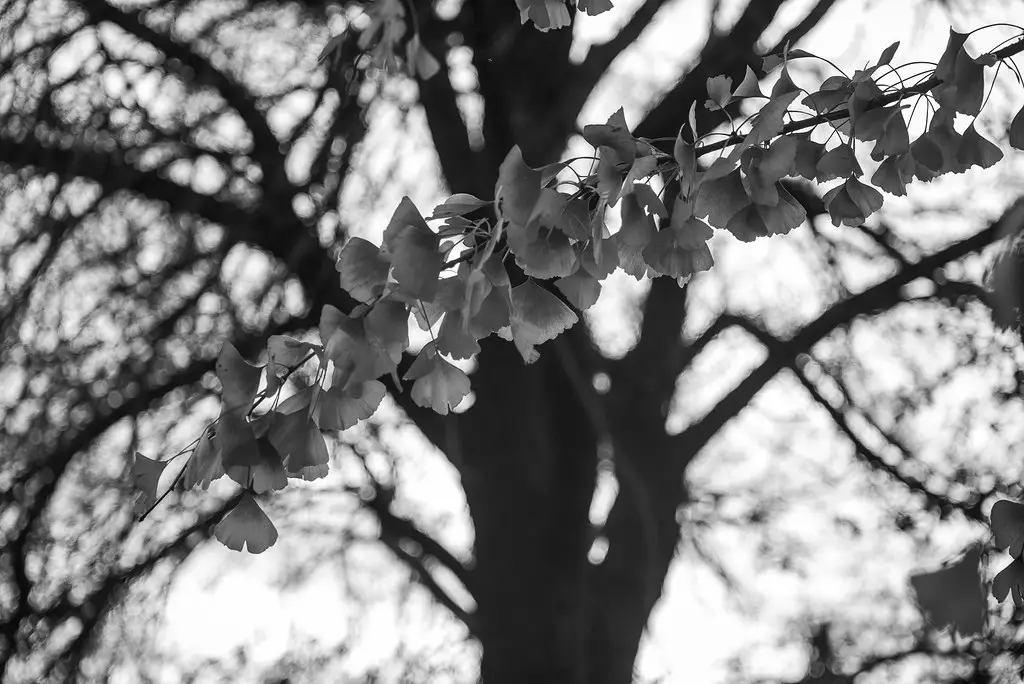
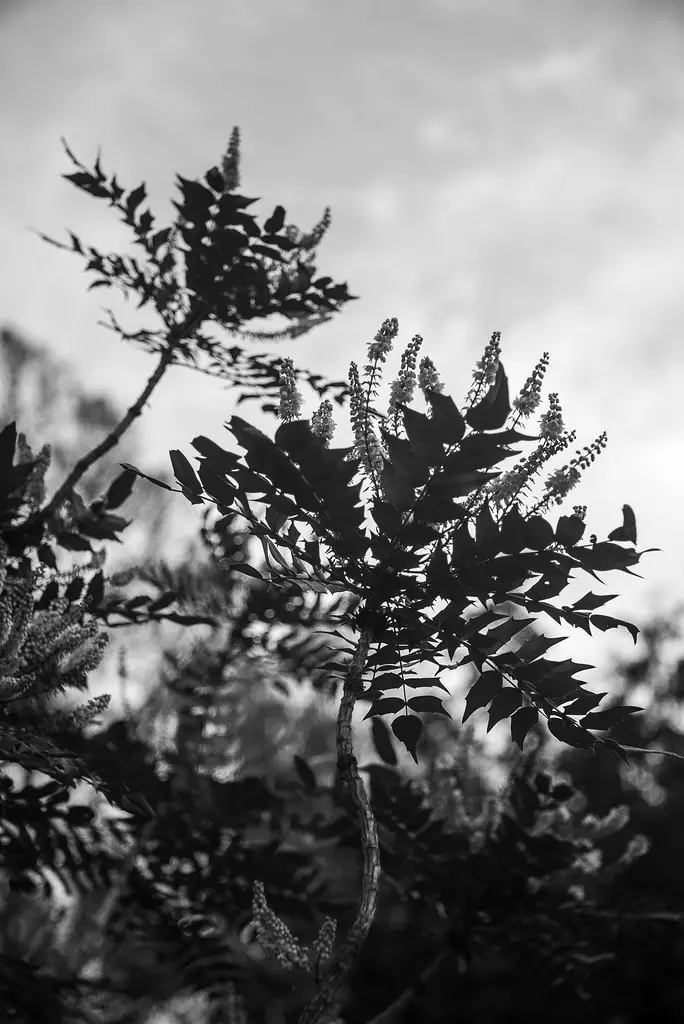
It definitely has something to do with the contrast this lens produces – sort of low but not in a washed-out kind of way, and with good detail. Lots of mid-tones and subtle transitions. This very moderate maximum aperture lens won’t blow your mind with funky bokeh but still manages to pack lots of vintage character.
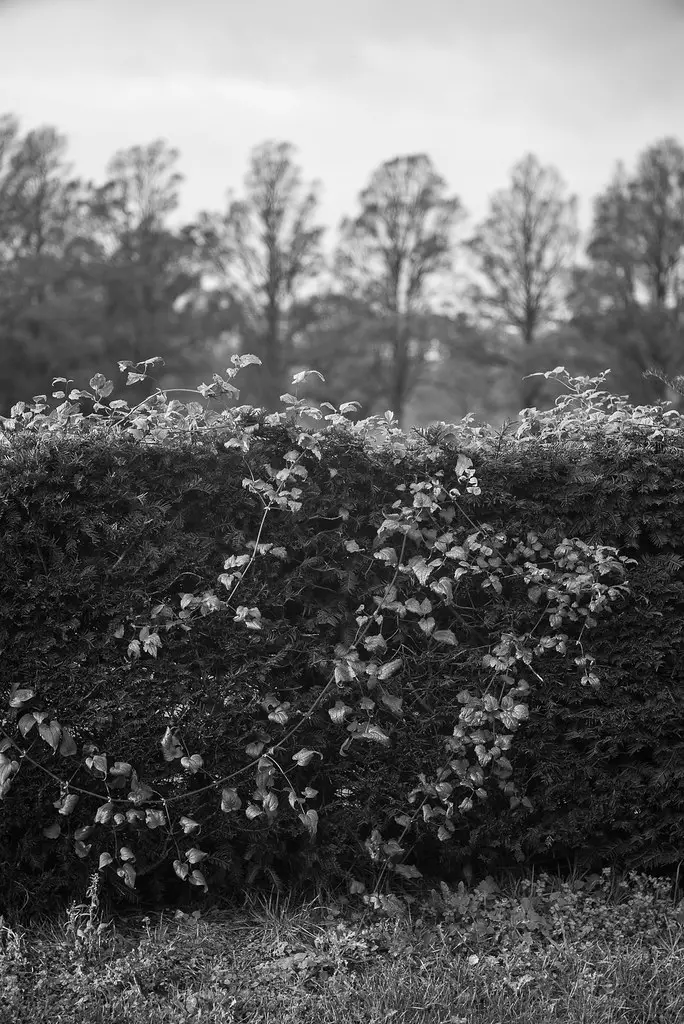
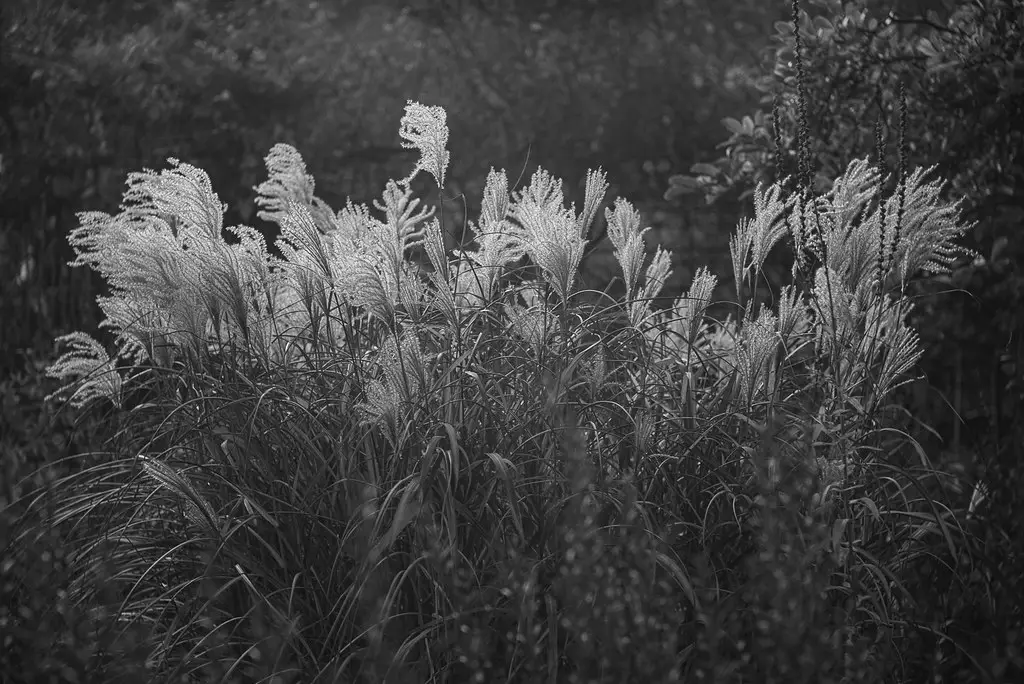
As you’d expect from a relatively slow lens, the 9cm Elmar is more than sufficiently sharp wide open. Sharpness drops to an extent in the corners but it’s still very much a lens that you can shoot wide open and not worry about it. It’s also very easy to focus. In my experience whether a lens behaves in terms of focus doesn’t always correlate to its maximum aperture. I’ve had some fast lenses that were more predictable than some of the slower ones.

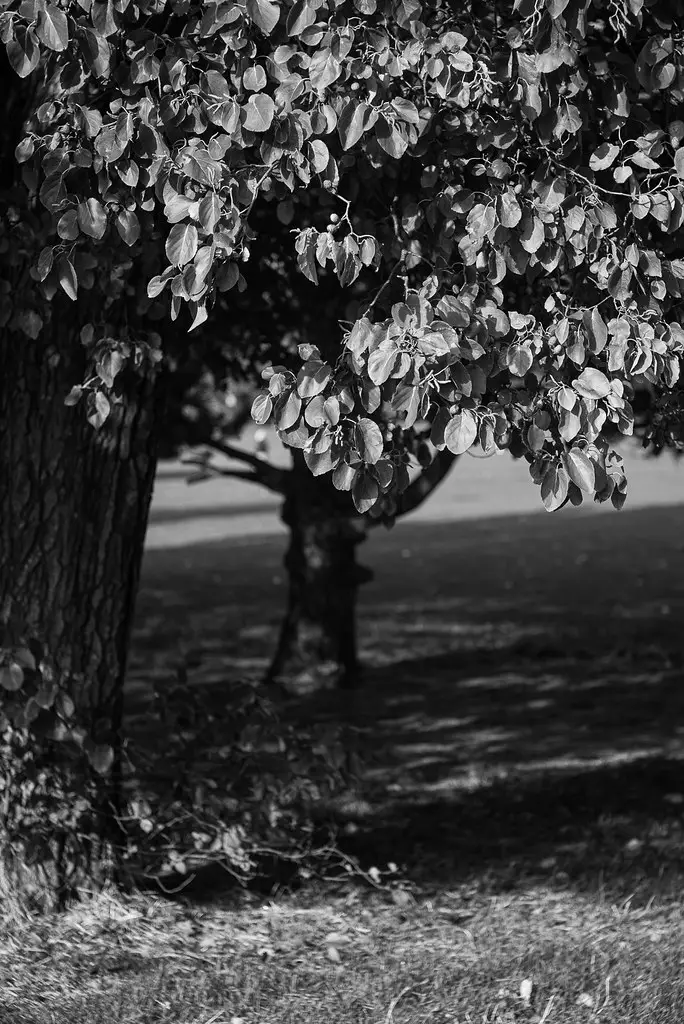
This lens is dependable. If you’re scaredy like me and don’t always feel comfortable shooting details of people’s homes, especially in the posher parts of town, you can take a cheeky shot and move on quickly without necessarily having to preview it or taking a bunch of follow-up shots. I like to call it shoot and scoot, sort of like the opposite of spray and pray. With this lens you won’t have to resort to prayer.
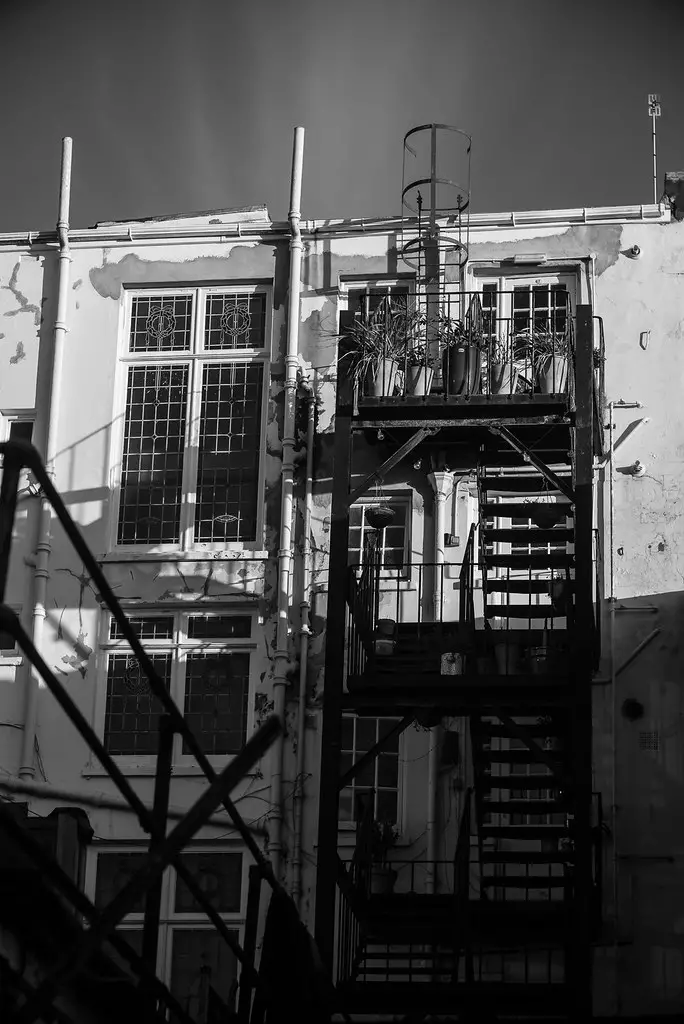
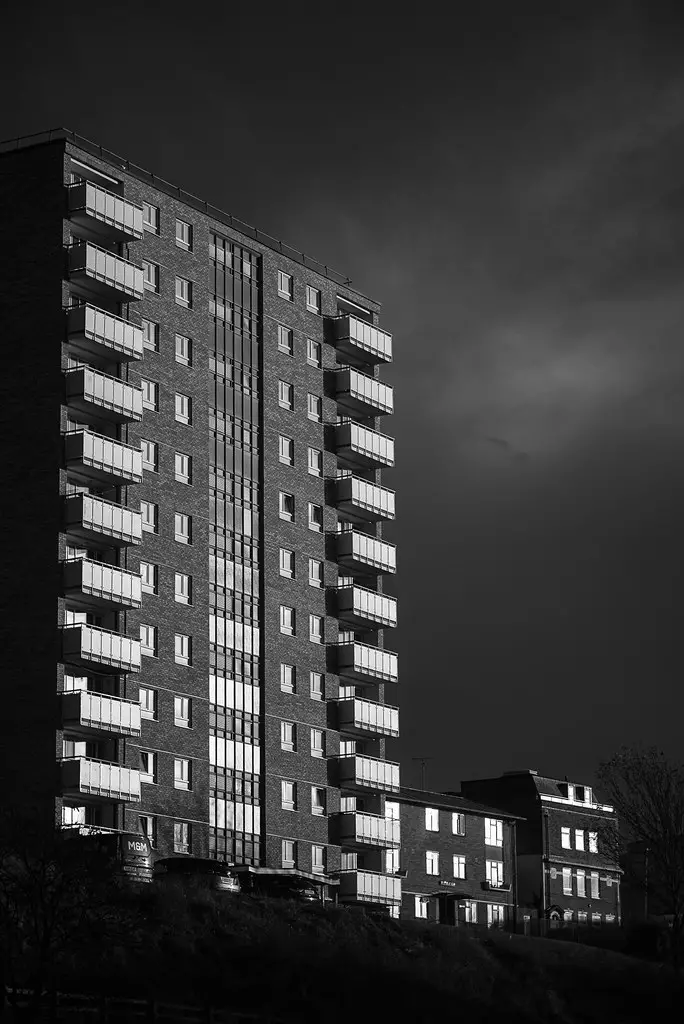
The good thing about longer lenses is that they don’t need to be very fast to produce some nice bokeh, especially at closer distances, both behind and in front of the subject. The bokeh produced by the 9cm Elmar isn’t overly busy, it’s not very bubbly or swirly either. It compliments the subject nicely instead of being the subject. Wide open, the images show a bit of a vignette, not too much to be overwhelming and probably easy to remove if you like correcting vignetting. It might be slightly too dark in the far corners but overall I find it quite subtle.
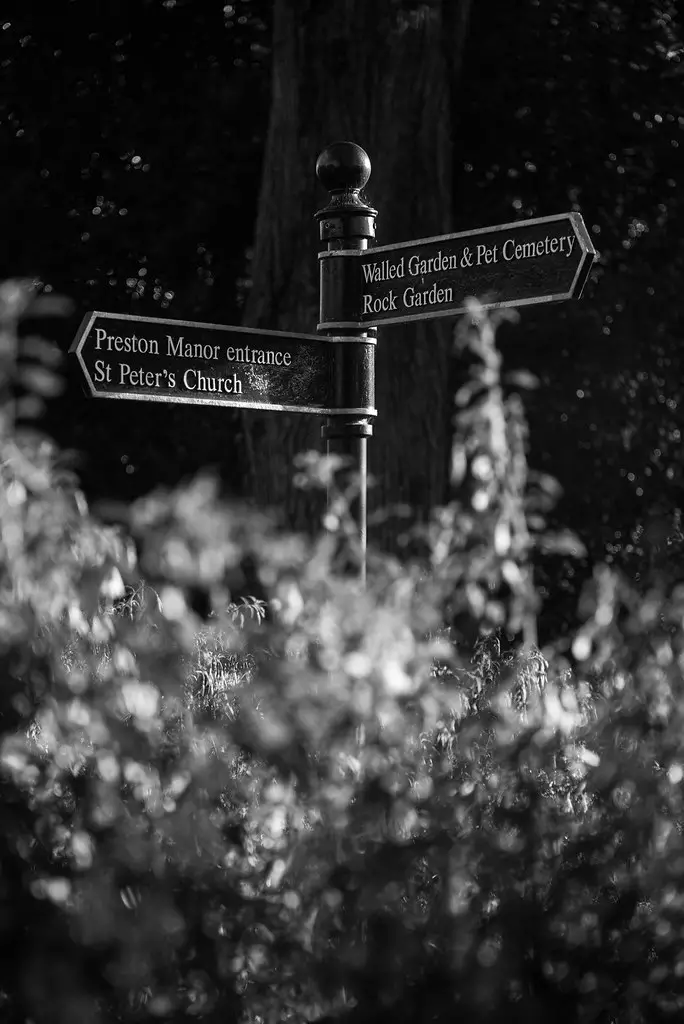
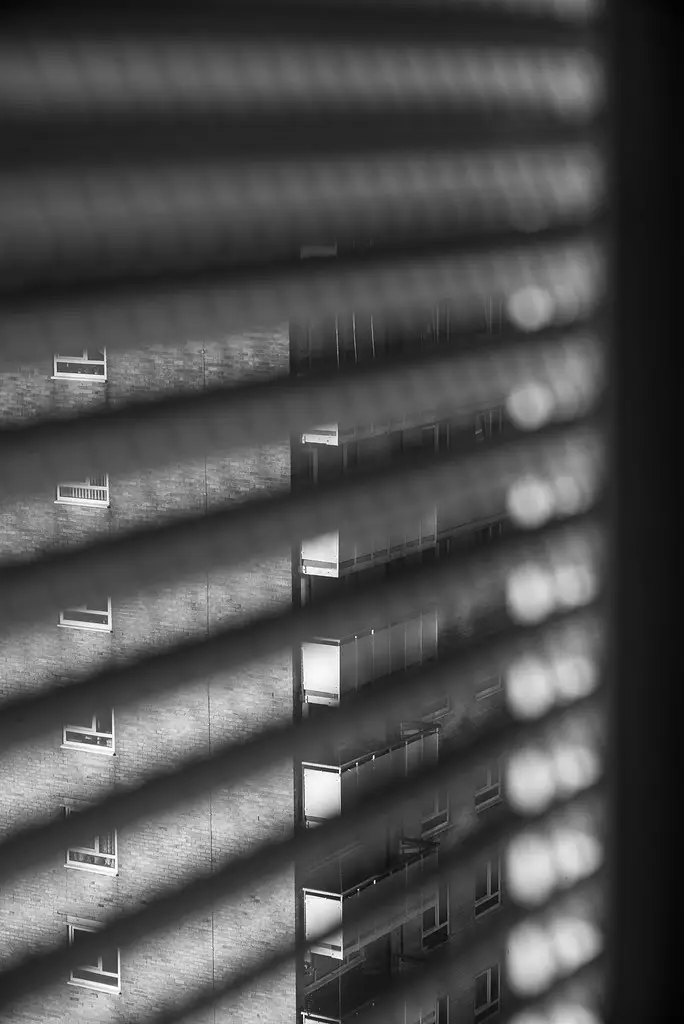
I’ve used this lens for some architecture photography and it worked really well. It produces great detail and textures, and I’ve never noticed any issues with distortion. It’s a good focal length for architectural detail. On sunny days the images come out with good strong contrast unless flaring occurs. Flaring manifests either by veiling the image and lowering its overall contrast or by creating these sickle-shaped artefacts. It’s not something that happens a lot though and most of the time I don’t bother with the hood.
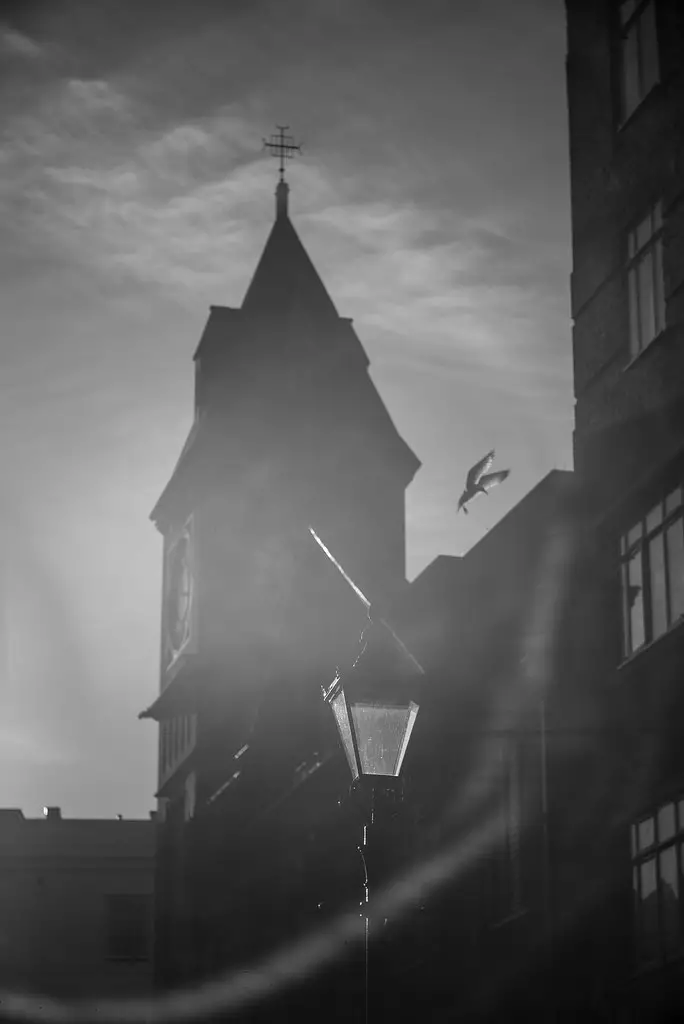
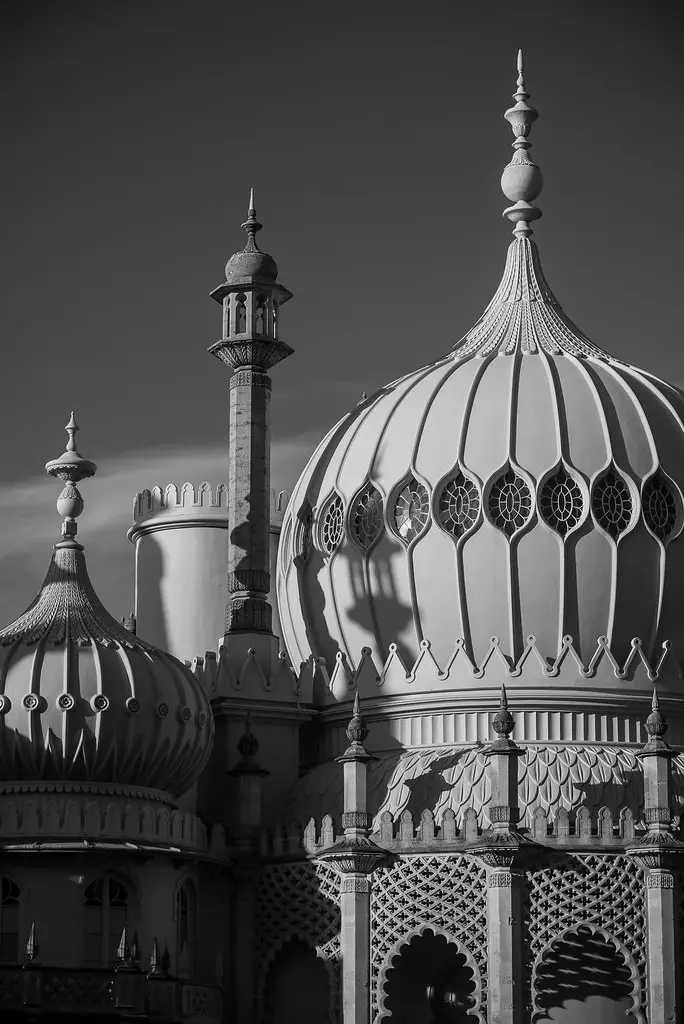
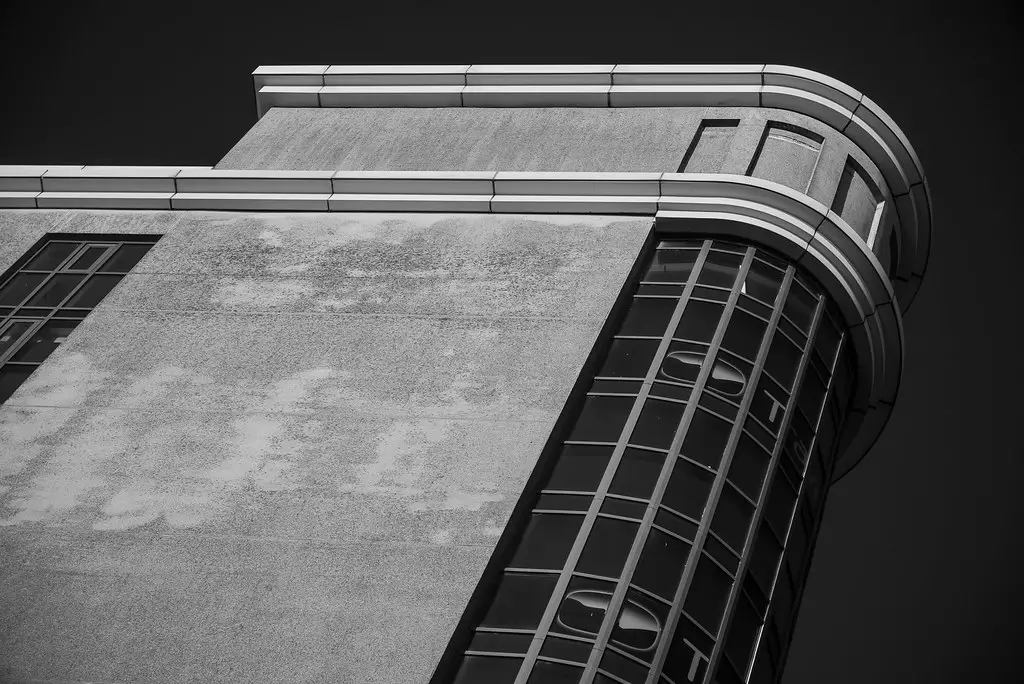
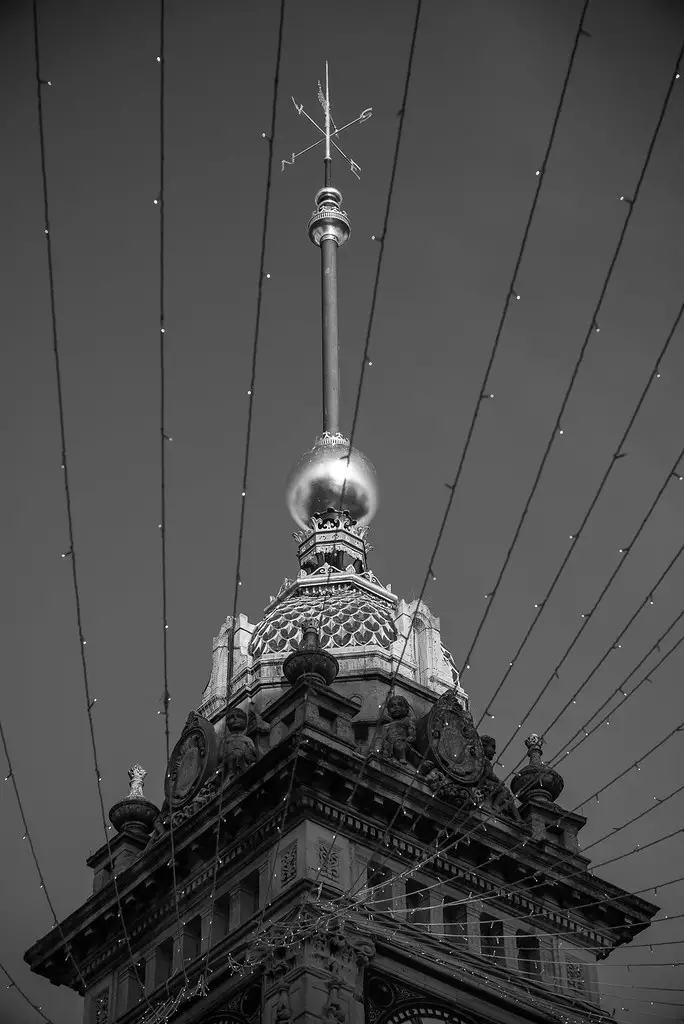
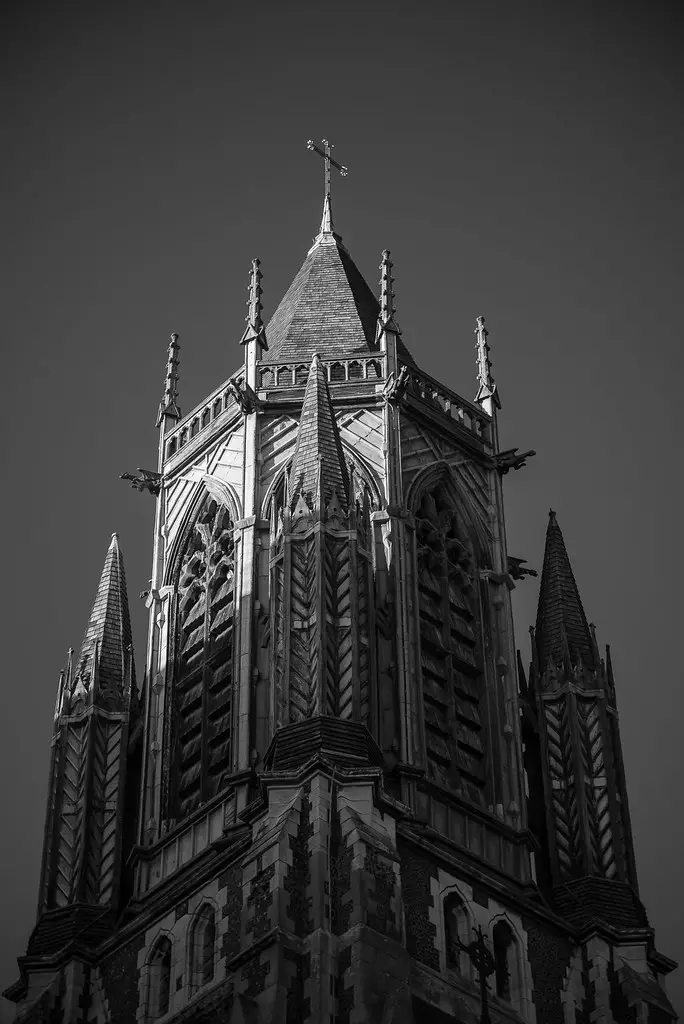
Final thoughts on the 9cm Elmar
When buying a slow lens, and f/4 certainly can’t be considered fast for a very moderate telephoto such as this one, you usually do so with a particular set of expectations. At least I do. There’s a lot that can be forgiven in the case of fast lenses, especially in terms of image quality. But a slow lens better offer at least acceptable sharpness at maximum aperture, good contrast, be easy to focus, and come in a relatively small and light package. Basically I expect the lens to be simple and practical. And the 9cm Elmar meets most of these criteria. Fast lenses offer more vintage character but they can also be a bit of a chore at times, especially if they’re heavy. Slower lenses allow for a more seamless shooting experience, they let you forget about the lens and focus on the photo.
Back in the day there were almost 80 thousand of these 9cm Elmar lenses made (this also includes the rigid version from the same era) and it’s still easy to find one in great condition. This is good news for those perhaps a little too shy to delve into Leica. This is a lens that’s affordable and readily available (also, worth noting, still very much repairable due to its high quality all mechanical construction) but carries all the hallmarks of what a Leica lens is supposed to be – beautifully made and producing great quality photos. And it was produced in the infamous Wetzlar factory so it’s a piece of photographic history. As another reviewer noted in a review of its older version, there’s no excuse not to own one.
Share this post:
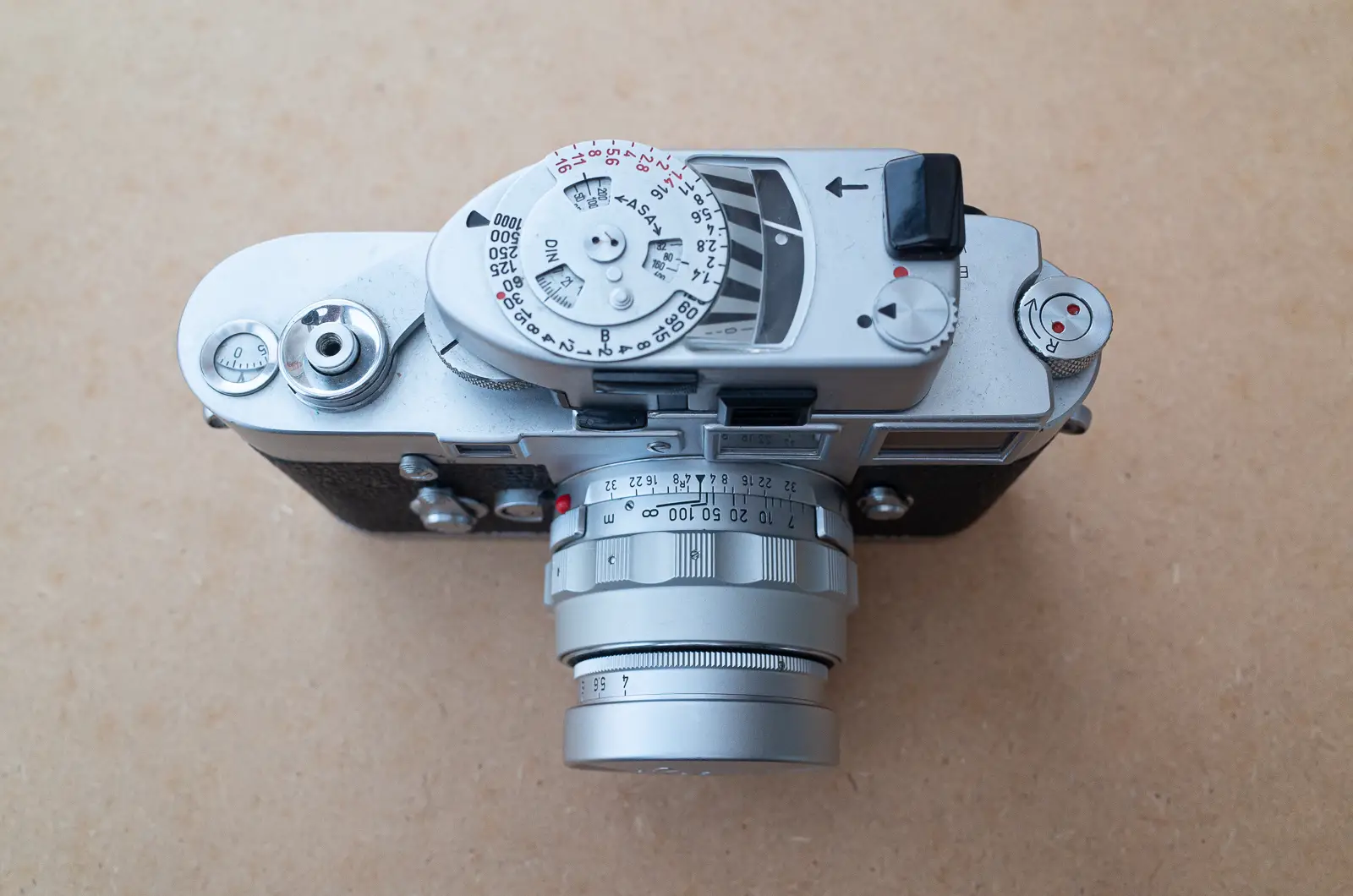








Comments
Bruce W Sewell on Ernst Leitz (Leica) Elmar 9cm f/4 Collapsible – The Near Perfect Slow Lens – By Agata Urbaniak
Comment posted: 06/12/2021
Bruce W Sewell on Ernst Leitz (Leica) Elmar 9cm f/4 Collapsible – The Near Perfect Slow Lens – By Agata Urbaniak
Comment posted: 06/12/2021
Bruce
Thorsten Wulff on Ernst Leitz (Leica) Elmar 9cm f/4 Collapsible – The Near Perfect Slow Lens – By Agata Urbaniak
Comment posted: 06/12/2021
Phil Steelandt on Ernst Leitz (Leica) Elmar 9cm f/4 Collapsible – The Near Perfect Slow Lens – By Agata Urbaniak
Comment posted: 06/12/2021
I liked your very nice reviews and photos on Nikon Lenses but with this one on the Elmar I know what you mean.
I have a 1951 one that I use with my 1951 Leica IIIc on film...mostly TMax.
The difference between our copies are that mine is a LTM lens, it's a non collapsible (rigid) lens, has a clickless aperture ring with 15 blades and there is no infinity lock.
What strikes me is the similarity between our copies.
I recognise in your digital black&white photos that the lenses "speak" the same language.
Yess, the Elmar is really a pleasure to use:
f/4 is forgiving in close focusing a portrait (I have to focus with the rangefinder window in the camera and compose with the turret finder and hope that the focus point didn't move too much)
This f/4 lens has more bokeh than I suspected. It is soft and never overwhelming, it isolates your subject beautifully from the background.
I totaly agree when you say that you can use the lens without a lenshood in a lot of situations.
The combo Elmar-Barnack Leica is very elegant.
My Sonnar 8.5cm f/1.5 (in Contax RF mount) is twice as heavy than the Elmar, it's quite challenging to nail the focus at f/1.5, is nearly unusable without a lenshood
And, indeed, it's an "affordable" Leica lens (I paid 300 euro for my copy)
I have also another overlooked "cheap" Leica LTM lens: the 3.5cm Summaron f/3.5
and to adapt Johnny Martyr's quote
There is no excuse not to own a "slower" Leitz ;-)
Comment posted: 06/12/2021
Phil Steelandt on Ernst Leitz (Leica) Elmar 9cm f/4 Collapsible – The Near Perfect Slow Lens – By Agata Urbaniak
Comment posted: 06/12/2021
I had them wonderfully restored by Chris Andreyo (Skyllaney) and wrote a story about their restoration here on 35mmc
I purchased an Elmar 1: 2.5 50mm because I didn'n knew if the original Sonnar was was salvageable (believe it or not, but the Sonnar was the matching lens with my Leica IIIc)
It's a collabsible Elmar and was fun to use: it makes the Barnack Leica really pocketable and I went on a cycling trip in France with it.
It's sharp and very easy to use, nothing wrong with it.
BUT...I never liked this lens.
I don't know why, there is no objective reason to dislike it, but I never had the feeling it was a lens for me.
the Elmar 9cm and the Summaron 3.5 cm are completely different in that aspect.
Maybe it is because i'm not a 50mm lover? The 50mm Sonnars forced me to reconsider my point of view about 50mm ;-)
I hope you will use all your marvelous glass on your Barnack-Leica and that you will enjoy it as much as I do.
thanks again for your "no nonsense" reviews
Nik Stanbridge on Ernst Leitz (Leica) Elmar 9cm f/4 Collapsible – The Near Perfect Slow Lens – By Agata Urbaniak
Comment posted: 07/12/2021
Don on Ernst Leitz (Leica) Elmar 9cm f/4 Collapsible – The Near Perfect Slow Lens – By Agata Urbaniak
Comment posted: 28/10/2022
Very thorough review. I see you have the lens mounted on the M240. Is it safe to collapse the lens while attached to the camera? Any danger of touching the sensor when collapsed? I have an M9 and am interested in this lens, but terrified of it unlocking from its extended position and collapsing into the sensor. Thank you in advance for your response.
Don
Comment posted: 28/10/2022
Don on Ernst Leitz (Leica) Elmar 9cm f/4 Collapsible – The Near Perfect Slow Lens – By Agata Urbaniak
Comment posted: 30/10/2022
Thank you so much. Good advice about the rubber stopper and the rigid version. I will look at it. Have a great day!
Don
Mike on Ernst Leitz (Leica) Elmar 9cm f/4 Collapsible – The Near Perfect Slow Lens – By Agata Urbaniak
Comment posted: 16/11/2022
Mike
Jens on Ernst Leitz (Leica) Elmar 9cm f/4 Collapsible – The Near Perfect Slow Lens – By Agata Urbaniak
Comment posted: 31/12/2022
my favourite shot are the Gingko biloba leaves.
With my Praktica or Contax SLR's i use CZJ Sonnar 135mm f4 or MOG Orestor 100mm f2.8 for midrange and for landscapes pics.
Toby Madrigal on Ernst Leitz (Leica) Elmar 9cm f/4 Collapsible – The Near Perfect Slow Lens – By Agata Urbaniak
Comment posted: 13/03/2023
This is a quality that will not be seen again.